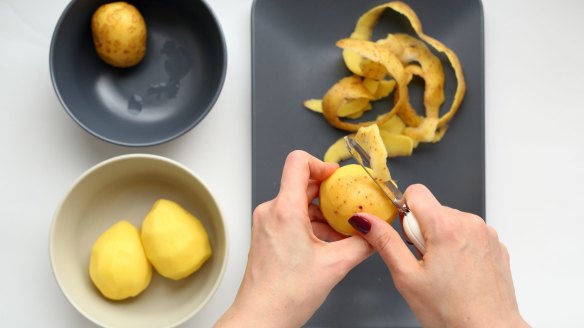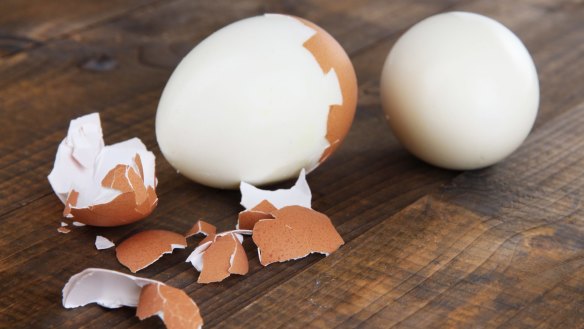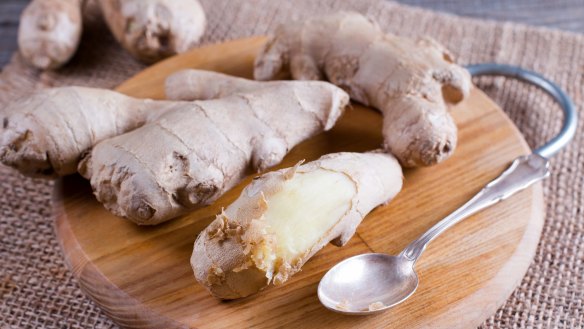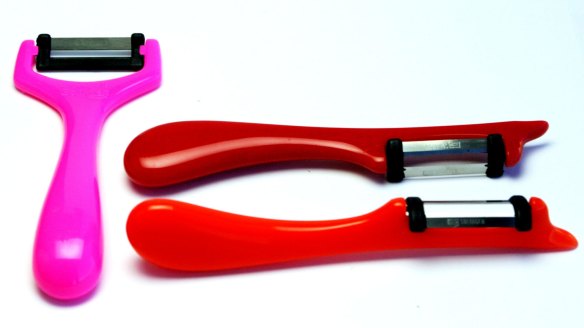How to peel potatoes, ginger, garlic, nuts and boiled eggs

We've road tested and rounded up the best peeling hacks to help make this arduous kitchen prep task as efficient and painless as possible.
Potatoes
There is nothing more irksome than peeling a bowl of potatoes. The trick: run a knife around the centre of a potato, piercing the skin only, rather than the potato flesh. Boil the potatoes as normal and strain. Apply pressure at each end of the warm potato – the skin will come away in your hands. You don't need to touch a peeler, plus you'll get added flavour from leaving the skin on during cooking.

Boiled eggs
Tiny bits of broken shell and eggs that resemble potholes on country roads will be a thing of the past with these steps:
1. Use a thumbtack to pierce a tiny hole on the bottom of each egg before you boil it. This creates an exit route for the small amount of air that expands as you cook the egg, making it easier to peel the shell away.
2. Add a heaped tablespoon of vinegar or baking soda to the water before boiling. The eggshell is made of calcium carbonate, and adding vinegar or baking soda to the water will dissolve some of the calcium carbonate, making the shell easier to peel.
3. Adding eggs to hot water makes for an easier peel than cooking from a cold-water start.
4. Peel the eggs as soon as they are cool enough to handle.

Ginger
Trim the piece of ginger of any small nubs. Holding the ginger in one hand, use a teaspoon to scrape away the thin layer of peel.
Garlic
Peeling garlic en masse or young heads of garlic is as tedious as it gets. Try this 20 second trick.
1. Set the bulb against a flat surface, with the tip of the shoot facing up. Strike the bulb with the heel of your palm and break off the cloves.
2. Place the cloves in a screw-top metal or ceramic container and close it tightly.
3. Vigorously shake the container for 15 to 20 seconds. You should now have fully or mostly peeled cloves.
4. Any remnants of peel can be removed using the flat part of a knife: hold the knife over the clove, and gently smash the surface of the knife with your palm. Don't apply too much force: do it swiftly and carefully and you'll easily be able to remove the rest of the peel by hand.
Coconut
There's nothing worse than trying to extricate coconut flesh from its tough husk. The trick: freeze the coconut overnight.
Once frozen, use a kitchen hammer or the butt of a knife to lightly tap the coconut to create cracks on the shell. Once the pieces fall off, you'll see the coconut flesh doesn't stick to the shell.
Nuts
If you baulk at paying twice the price for some bald nuts in the supermarket, blanching or toasting can help lessen the blow of removing the skin from raw nuts.
To blanch: For every cup of nuts, bring two cups of water to a boil and add three tablespoons of baking soda. Boil the nuts for three to four minutes, strain, then submerge the nuts in an ice bath. Strain again, and the skin should now rub off easily. Dry the nuts with a tea towel and they are ready to use. This method is particularly useful for hazelnuts, almonds and pistachio kernels.
To toast: Preheat the oven to 200C. Spread the nuts on a baking tray in a single layer. Toast them in the oven for 10 to 15 minutes or until fragrant and the skins appear crisp, shaking the tray once or twice so they toast evenly. Allow to cool before rubbing between two tea towels – the skins should flake off.

Best peelers for lefties
Peeling anything as a southpaw with the peeler in your opposite hand is frustrating – you have to hold the peeler backwards and pull the blade towards you, which slows down the prep and exposes your fingers to accidental slices. If you're left-handed, look for these peelers:
Swivel peeler: the reverse blade allows lefties to peel away from their body with their dominant hand.
Y-shaped peeler: the horizontal blade can be used to peel the skin towards you.
The best recipes from Australia's leading chefs straight to your inbox.
Sign up